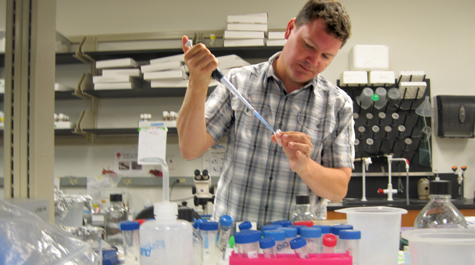A professor (and his class) contribute to a 1,000-author evolution study
You have to look pretty closely to find Matthew Wawersik’s name on this paper. The list of authors and their affiliations goes on for most of four pages.
But there he is, near the bottom of the first page, one of more than 1,000 researchers who made significant contributions to “Drosophila Muller F elements maintain a distinct set of genomic properties over 40 million years of evolution,” published in the journal G3: Genes, Genomes, Genetics.
Wawersik, an associate professor in William & Mary’s Department of Biology, says that the actual number of contributors to the project might be many as four times greater.
Thousands of people working together on a single project? How can this happen?
These mega-author collaborations are becoming more common in science. A group of physicists associated with CERN recently broke the record for multi-author papers with an effort that bore the names of more than 5,000 authors.
Such extensive collaborations have come about for a number of interlocking reasons. First, many of the scientific questions of today are beyond the scope of a single individual or even a small group of scientists. Secondly, the amount of data generated by complex investigations such genomics studies or high-energy physics experiments absolutely require a large number of scientists for processing. Finally, the data can be digitized and shared remotely.
The Internet and the World Wide Web were both created so that scientists can share data. The ability to bring many minds to bear on a single project is one of the advantages brought about by the new age of in silico research, Wawersik explained. In silico means that the experimenters work with data on computers. The term is an Internet-age extension of the concepts of research conducted in vitro (under glass, such as in a petri dish) and in vivo (in the body.) In silico methods are especially suited for genomics research, such as the G3 paper, which looks at a particularly persistent chromosome that’s present in certain species of fruit flies.
The paper is a comparative examination, looking at the genetic structure of the fourth chromosome in four different species of fruit flies. Wawersik noted that the Muller F chromosome differs from the other three chromosomes in the Drosophila genome by being heterochromatic, or highly condensed.
“It’s called a dot chromosome, and it contains about 80 genes,” he said. That’s a small fraction of Drosophila’s total of 15,000 genes. Wawersik added that one interesting aspect of the Muller F is that despite its “non-standard” status, the 80 genes inside the dot chromosome stay very much on the job, producing proteins — gene expression, in other words.
“Many of these genes have what is called ‘housekeeping function,’ doing things that keep the fly alive,” he said.
The other interesting thing about the Muller F is its persistence. The dot chromosome has remained virtually intact in the genomes of a number of Drosophila species over 40 million years, Wawersik said.
“This paper is basically the work of many, many people delving into these genomes to see what they look like,” he explained. “You could do this with a sample of one — one genome. But when you’re talking about the Muller F, something that’s highly conserved evolutionarily over 40 million years, looking at multiple species allows you to examine common themes that control gene regulation, as well as uncover subtle differences amongst species.”
The “many, many people” Wawersik mentioned included a large number of undergraduates, including members of his Genomics and Functional Proteomics class from the spring semester of 2009.
BIOL 404’s enrollment is around 10 or 12 students each time it’s offered and Wawersik said each class does work that contributes to a larger study, such as the Muller F paper. All of these large studies are organized and coordinated at the Genomics Education Group, based at Washington University in St. Louis.
“It’s really Sarah Elgin who runs this project. She is a force of nature,” he said.
The Wash U.-based multi-institutional collaboration has received significant endorsement in terms of funding from the Howard Hughes Medical Institute (HHMI) Precollege and Undergraduate Science Education Professors Program, the National Institutes of Health and the National Science Foundation.
Wawersik’s BIOL 404 course is one of many classes at William & Mary that serve as a bridge between classroom instruction and research participation. Similar classes exist at other schools, of course, and Wawersik and other Genomics Education Group participants have collaborated on papers that emphasize the educational benefits of the projects.
Such an in silico collaboration is especially attractive for community colleges or schools with small bio departments that don’t have wet-lab facilities to maintain a Drosophila program: “All you need is a student with a laptop,” he said.
“Not everyone has the lab I have here at William & Mary. I have the luxury of being able to bring my students into the lab and do directed research projects here under my supervision,” Wawersik explained. “This gives institutions that don’t have the facilities the opportunity to offer their students a real research project.”















